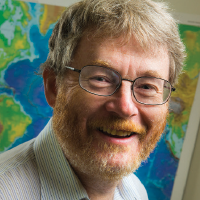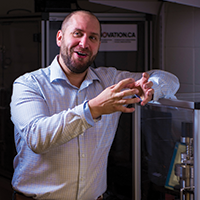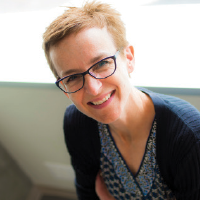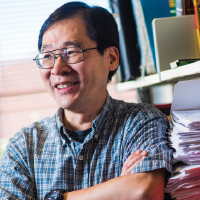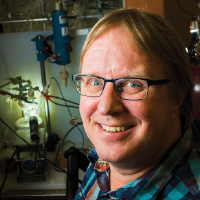Researchers in the Faculty of Science and from across campus are honing the future of energy, with a focus on developing new technologies as well as finding solutions for the challenges presented by our legacy energy systems. Doing so starts with a full-systems approach through the University of Alberta's Future Energy Systems research initiative, which connects more than 100 researchers and close to 300 graduate students from across seven faculties and campuses. Future Energy Systems is funded with $75 million from Government of Canada's Canada First Research Excellence Fund, and has launched more than 60 projects. Learn how six Faculty of Science researchers from across disciplines are changing the face of energy in Alberta, Canada, and globally. With upwards of five new projects involving Faculty of Science researchers on the horizon, the future of energy in Canada and around the world is looking bright.
Geothermal Energy
Geothermal Energy is the next hot thing-literally- in Alberta, with the potential to leverage a clean, renewable resource and fuel a new, sustainable industry. The concept is simple: pump hot water from underground to Earth's surface using wells. Use that heat to create power, and then inject the cooled water back into the ground at another local site, where it will heat up again. This emerging energy source has the advantage of using the same infrastructure as the oil and gas industry.
Target practice
Professor Martyn Unsworth is using his geophysical expertise to look underground and the best places to extract the hot water needed for geothermal energy production.
His work involves generating images of underground rock structure using radio waves and other signals to identify the best locations for drilling. "What works in one geographical location doesn't work everywhere worldwide," explains Unsworth. "We're looking at a range of energy technologies that will work together. We have to have a system in combination."
One of the challenges of developing geothermal energy is that it requires a larger initial investment for drilling wells. However, geothermal has the major advantage that it works 24 hours a day, year-round, unlike many other renewable energy sources, making it a complement to other sources of renewable energy.
Pilot project in Alberta
Research associate Jonathan Banks is bringing a pilot project in geothermal energy to Alberta. In partnership with local company Epoch Energy, Banks and his colleagues are working to retrofit oil wells near Hinton with the potential to provide megawatts of power to the local community.
"We'll use the same infrastructure, the same expertise, the same service providers, and the same software," says Banks. "It's really just a matter of retooling and retraining the capacity that we already have. Alberta is at a huge advantage for getting started without the steep and expensive learning curve other places are facing."
With his colleagues, Banks is working on reservoir modelling that makes geothermal energy projects possible by finding reservoirs, determining their thermodynamic properties, and modelling fluid flow.
Solar Power
The solar cells that convert solar energy are notoriously inefficient to create. Traditionally composed of silicon, created from sand in an energy-intensive process, individual cells can take two to four years to recoup the initial energy required for their creation. And though solar energy is abundant, the use of solar power could be much more common than it currently is.
Sunnier prospects
Chemist Jillian Buriak is working to develop inexpensive and manufacturable solar cells. Called the 24-hour solar cell, this technology aims to recoup the energy needed to make it in the space of a single day. The technology grows out of a collaboration with the group of Arthur Mar, and uses machine learning to develop efficient solar cells much faster.
"It's kind of a dream. Realistically, right now, we're looking at recouping that energy in the space of a few months; but compared to silicon solar cells that require about two years, we are in a strong position," explains Buriak, Canada Research Chair in Nanomaterials for Energy.
Buriak and her research collaborators are exploring Earth-abundant alternatives to silicon-and the prospects look extremely sunny. In addition to alternatives to silicon, Buriak's group is looking for more flexible, lightweight materials that can be rolled on or spray-coated to a surface, noting that this will help decrease capital and labour costs during initial installation.
The power of AI
Part of the challenge in identifying alternative materials is the labour required to weed out materials that won't work. Enter Arthur Mar, UAlberta chemist, who is harnessing the power of artificial intelligence to identify new materials to be used on solar cells.
"My lab is acting as the bridge between the computing scientists who develop the algorithms of machine learning tools and those who want to apply this information to make new things," says Mar.
Using these algorithms, Mar and his team will screen many potential materials to identify the required components of the ideal solar cell material in hopes of building more efficient and powerful cells. From here, Buriak and her research team will investigate the proposed materials over the next two to three years.
Biofuels
The traditional methods of producing energy, including the extraction and refinement of oil and gas, produce emissions that contribute to the greenhouse effect. In some cases, these emissions are byproducts of production, such as carbon dioxide. There are also "fugitive" emissions, when there is not enough of a particular byproduct produced to become something useful but too much to release into the atmosphere without consequence. But what if it were possible to capture these emissions and make them into something useful while also mitigating their negative impact on our environment?
Carbon: zero
Chemist Steven Bergens is looking for ways to reduce the carbon footprint of oil refinement to nearly zero-all with the help of a seemingly simple chemistry equation.
"The idea is to take carbon dioxide and create something valuable-like fuels and chemical building blocks," says Bergens. "Our job is to develop efficient, inexpensive catalysts that are connected to solar energy collectors that make these chemical reactions possible."
Specifically, Bergens hopes to combine carbon dioxide, water, and sunlight to create liquid fuels, carbon monoxide, or methane. Using fuels and products made from carbon dioxide, sunlight, and water would dramatically reduce the total amount of carbon dioxide released into the atmosphere. And with a few promising systems already in the works, the future is looking bright.
Small but mighty
Microbiologist Lisa Stein is developing bacteria that will create useful biofuels from oil and gas production waste products, such as methane. In conjunction with colleagues across campus, Stein is developing a small-but-mighty bioreactor that will capture waste methane emissions and convert them into something useful.
"Essentially, we take single carbon molecules and create complex organic materials, thereby adding a lot of value to these waste products," says Stein. "Combining that waste methane with our bacteria, we can create biofuels like biodiesel and isoprene."
Smokestack flares are the result of "fugitive" methane emissions in many industries, from water treatment plants to paper mills to oil and gas refineries. The proposed bioreactor will have the capacity to make this fugitive methane useful. Stein's bacteria combined with this technology will effectively close the loop in our legacy energy system.
